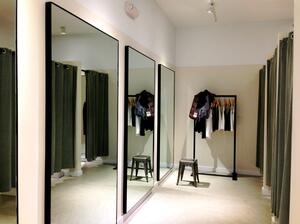A Call for Inclusion on the Catwalk
For the longest time, mirrors were my sworn enemy. Dressing rooms were the battlegrounds of a war between comfort and confidence, and my body was caught in the middle of it. On some days, every curve I had was subject to thorough self-scrutiny. Stomachs had to be sucked in, and spandex was a girl’s best friend. On other days, I avoided looking at myself at all costs, as though my body was something to be ashamed of. I knew it wasn’t, but sometimes I just couldn’t keep the thought from running through my mind.
My experience is not unique. Millions of girls worldwide worry and obsess about their bodies as if America’s Next Top Model and Teen Vogue were gospel. We are taught by the fashion industry and by social media that skinny equals pretty. And although there may be an increasing amount of curvy girl representation (I see you, Ashley Graham), catwalks and magazine spreads are still lacking diversity in how beauty is defined. Those who rule the industry have the power to expand the definition of beauty, but curves and thighs and hips won’t be textbook beautiful until the body shaming epidemic that plagues the fashion industry comes to an end.
This is precisely what infuriates me about Karl Lagerfeld, a German fashion designer with a penchant for skinny models. He walks in the shadow of controversy and is no stranger to the world of body-shaming. His claim that “nobody wants to see curvy women on a catwalk” still blows my mind. How could someone who thrives off of an industry that idolizes the female body be so discriminatory?
The answer is simple: Lagerfeld’s opinions are the product of a business that treats beauty as a single, easily-definable concept. For decades, the media and popular culture have stressed the idea that “beautiful” is etched into lithe limbs and willowy frames. They’ve insisted that men find women who are thinner more attractive, as if a woman’s goal in life is to please men. Fad diets are popularized by internet and Hollywood royalty. And if any female celebrity dares step onto a beach in a bikini, their picture ends up on the cover of an overly-critical tabloid magazine.
This is the world that both I and Karl Lagerfeld live in. As someone who used to cut the size tags out of all my garments, I understand how easy it is to be swayed into thinking a certain way about beauty. Lagerfeld believes that curvy women don’t belong on a runway because no one else–not another designer, or a model, or high-end fashion empire–has deemed it truly acceptable. He works to please an industry that sees larger bodies as less valuable and less attractive than thinner ones. Meanwhile I sit behind my computer screen, wondering how I can show him and countless other people that my curves are beautiful.
Today, the average size of a woman in the United States is between 16 and 18. Although I can’t change the fashion world’s opinions overnight, designers need to know that by refusing to dress certain body types, they are doing a disservice not just to consumers, but also to themselves. Eventually, Lagerfeld and others have to recognize that acknowledging all body types as beautiful, and as worthy of the fashion industry’s attention, will ultimately benefit all parties involved.
Because of countless body positivity movements and experiences I have had throughout the last few years, I have been able to become more confident in who I am as a young woman. My mirror is no longer my enemy, and now, self-love is the army fighting on my side during dressing room battles. Body positivity is the antidote to the fashion industry’s discriminatory and body-shaming practices. While it’s something that has helped me realize that I don’t need the fashion industry to validate my body, I still believe that fashion should acknowledge and celebrate all body types. It’s wrong that the fashion industry ignores the majority of American women, and instead chooses to focus on a small percentage that, while beautiful, doesn’t reflect the wide range of body types. Instead of stripes and t-shirt dresses, let’s make inclusivity this season’s (and every season’s) hottest trend.
This piece was written as part of JWA’s Rising Voices Fellowship.







